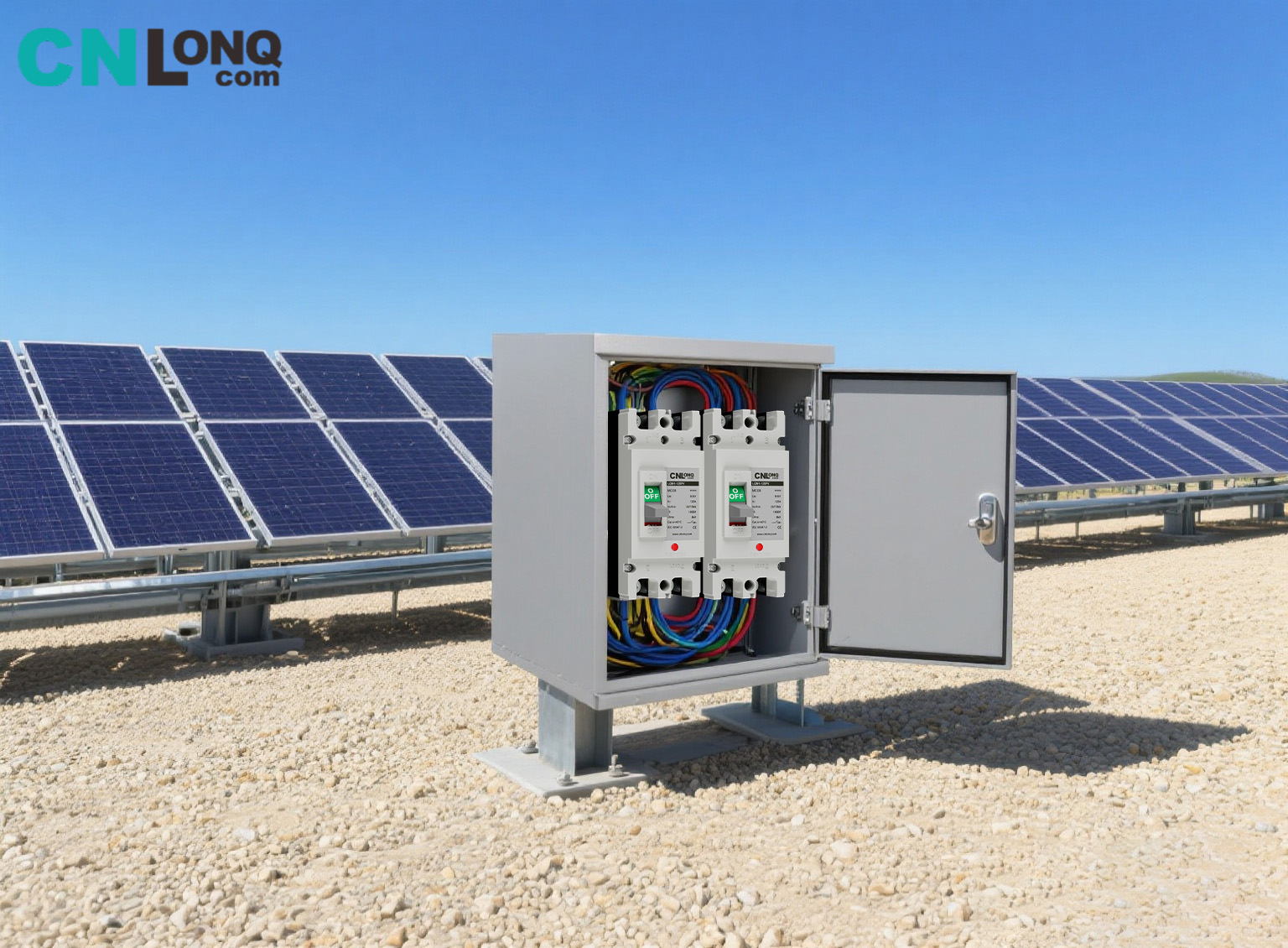
- English
- Español
- Português
- русский
- Français
- 日本語
- Deutsch
- tiếng Việt
- Italiano
- Nederlands
- ภาษาไทย
- Polski
- 한국어
- Svenska
- magyar
- Malay
- বাংলা ভাষার
- Dansk
- Suomi
- हिन्दी
- Pilipino
- Türkçe
- Gaeilge
- العربية
- Indonesia
- Norsk
- تمل
- český
- ελληνικά
- український
- Javanese
- فارسی
- தமிழ்
- తెలుగు
- नेपाली
- Burmese
- български
- ລາວ
- Latine
- Қазақша
- Euskal
- Azərbaycan
- Slovenský jazyk
- Македонски
- Lietuvos
- Eesti Keel
- Română
- Slovenski
- मराठी
- Srpski језик
Understanding Molded Case Circuit Breakers (MCCBs): The "Guardians" of Electrical Circuit Safety
2025-10-08
In low-voltage power distribution systems, there is a key device quietly safeguarding circuit safety — the Molded Case Circuit Breaker (MCCB). Unlike large motors that operate with a roar or precision instruments that attract attention, the MCCB has become an indispensable "safety guardian" in scenarios such as industrial production, building electrical systems, and new energy applications, thanks to its strong protection capabilities and wide adaptability. Today, we will explore this device from multiple dimensions to uncover the secrets of how it protects circuit safety.
I. Getting to Know MCCBs: What Are They, and What Makes Them Different?
Essentially, an MCCB is a protective electrical device used in low-voltage power distribution systems, with its core role as the "guardian" of circuit safety. Structurally, it mainly consists of high-strength insulated plastic enclosures, conductive contacts, and trip units. The insulated enclosure not only protects internal components from external interference but also effectively prevents electric shock hazards.
Many people confuse MCCBs with the more common Miniature Circuit Breakers (MCBs), but there are significant differences between the two. Compared to MCBs, MCCBs have a higher rated current (typically ranging from 63A to 1600A) and stronger breaking capacity, enabling them to handle high-power electrical scenarios. For example, MCBs are commonly used in household socket and lighting circuits, while MCCBs are more relied on for protecting motors in factory workshops and main power distribution circuits in large buildings.
II. Unveiling Core Functions: How Do MCCBs Protect Circuit Safety?
The core value of MCCBs lies in "protection," which can be broken down into three key functions to counter circuit fault risks from different dimensions.
First is overload protection. When the current in a circuit continuously exceeds the rated current of the circuit breaker — such as when multiple devices in a factory start simultaneously, causing excessive load — the bimetallic strip inside the breaker heats up and deforms due to the thermal effect of the current. This then triggers the tripping mechanism to quickly cut off the circuit. This process effectively prevents the insulation layer of wires from being burned due to prolonged overheating, stopping fires at the source.
Second is short-circuit protection. A short circuit is one of the most dangerous faults in a circuit. When it occurs, the sudden surge of massive current can burn out equipment and even cause explosions. At this point, the electromagnetic trip unit of the MCCB comes into play: the strong electromagnetic force generated by the large current rapidly attracts the iron core, driving the tripping mechanism to cut off the circuit in milliseconds — like an "emergency brake" for the circuit — minimizing fault losses to the greatest extent.
Additionally, depending on the needs of different application scenarios, MCCBs can be equipped with additional protection functions. For instance, adding a residual current module enables leakage protection to prevent electric shocks; installing an overvoltage/undervoltage protection module safeguards precision equipment from damage caused by voltage anomalies, fully demonstrating the flexibility of its functions.
III. Key Parameters: The "Hard Indicators" for Selecting the Right Device
To ensure MCCBs provide optimal protection, selecting the right parameters is crucial. The following core parameters directly determine whether a circuit breaker can be adapted to specific electrical scenarios.
The rated current (In) is a fundamental parameter, referring to the maximum current that the circuit breaker can continuously carry. It must be accurately matched according to the load power. For example, in a photovoltaic (PV) system, the MCCB’s rated current should be selected based on the output current of the PV array — it should not be too small (to avoid frequent tripping) nor too large (to prevent losing its protective purpose).
The breaking capacity (Icu/Ics) is related to fault-handling capability, referring to the maximum fault current that the circuit breaker can safely interrupt. When selecting an MCCB, it is necessary to consider the calculated short-circuit current value of the power distribution system. If the breaking capacity is insufficient, the circuit breaker may fail to effectively cut off the circuit during a short-circuit fault, leading to more serious safety accidents instead.
The rated voltage (Ue) must match the voltage level of the circuit. Common ratings include 220V single-phase and 380V three-phase. A mismatch in voltage will not only affect the normal operation of the circuit breaker but may also damage internal components.
The tripping curve determines the protection sensitivity. Common curve types (B, C, D) are suitable for different loads. For example, Curve C is applicable to lighting and general power loads, while Curve D — with stronger tolerance for inrush currents — is more suitable for equipment with high starting currents, such as motors and compressors.
IV. Wide-Ranging Applications: A "Safety Barrier" from Industry to Daily Life
With its excellent performance, MCCBs are applied in almost all aspects of low-voltage power distribution.
In the field of industrial power distribution, MCCBs act as "safety managers" in factory workshops, providing overload and short-circuit protection for high-power equipment such as motors, production lines, and large machine tools, ensuring production processes are not interrupted by circuit faults.
In building electrical systems — whether in shopping malls, office buildings, or high-rise residential buildings — MCCBs are often used as main switches in distribution boxes or protection switches for floor power distribution. They safeguard the electrical safety of the entire building and prevent large-scale power outages or fires caused by local circuit faults.
In the new energy sector, their role is equally critical. In PV systems, MCCBs are installed in combiner boxes and on the inverter side to protect the output circuits of PV arrays; in energy storage systems, they guard battery circuits, preventing safety risks such as overcharging and short-circuiting of batteries, and providing protection for the application of clean energy.
Even in civil high-power scenarios such as villas and large residences, MCCBs can provide reliable protection for high-power household appliances like central air conditioners, electric water heaters, and whole-house water purification systems, solving the problem of insufficient rated current in ordinary MCBs.
V. Core Advantages: Why Are MCCBs the "Preferred Choice"?
Compared with other protective devices, MCCBs have distinct advantages — a key reason for their widespread application.
Strong environmental adaptability is a major highlight. The high-strength insulated plastic enclosure can withstand harsh environments such as high temperatures, low temperatures, humidity, and UV radiation. Whether in outdoor PV power plants or basement distribution rooms, MCCBs can operate stably and are less likely to age or fail due to environmental factors.
High reliability is reflected in the precision of core components. Key parts such as trip units maintain stable accuracy, and there is little risk of misoperation or protection failure during long-term use, providing continuous protection for circuit safety.
Easy operation and maintenance lowers the threshold for use. With a compact structure and moderate size, MCCBs can be directly integrated into various power distribution equipment without complex tools during installation. Daily maintenance only requires regular checks for enclosure damage or loose wiring, and a yearly manual test of the "trip button" — no frequent component replacement is needed, significantly reducing operation and maintenance costs.
Furthermore, good expandability allows MCCBs to adapt to intelligent needs. By adding auxiliary contacts and alarm modules, functions such as remote monitoring and fault alarming can be realized, meeting the requirements of intelligent management in modern power distribution systems.
VI. Usage and Maintenance: Ensuring the "Guardian" Works Long-Term
To ensure MCCBs maintain stable performance over the long term, standardized use and regular maintenance are essential.
Strict adherence to installation standards is required. When wiring, terminals must be tightened to avoid overheating caused by poor contact; live wires, neutral wires, and ground wires must be connected correctly. Reversing the polarity may render the protection function ineffective, creating potential safety hazards.
Daily maintenance should not be neglected. It is recommended to check for enclosure damage or cracks and loose terminals every quarter. Each year, manually press the "trip button" to test if the protection function works normally — if the button fails to trigger a trip, timely inspection or replacement is necessary.
At the same time, replacement taboos must be kept in mind: after a fault-induced trip, do not reset the breaker blindly. First, identify the cause of the fault (e.g., overloaded equipment or short-circuit points in the line) and only reset it after the fault is resolved. If the breaker trips repeatedly or the enclosure is damaged, it should be replaced promptly even if there is no obvious external damage — "faulty operation" is not allowed, as it may lead to safety accidents due to equipment aging.
From basic structure to core functions, from parameter selection to practical application, MCCBs build a solid "safety barrier" for low-voltage power distribution systems. Understanding and using them properly will better ensure circuit safety and provide strong support for the stable operation of production and daily life.




